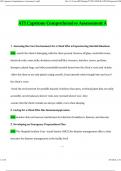ATI Capstone Comprehensive Assessment A.pdf file:///C:/Users/HP/Desktop/TYPA%20NEW/ATI%20Capstone%20C
ATI Capstone Comprehensive Assessment A
1. Assessing the Care Environment for a Client Who is Experiencing Suicidal Ideations
ANS -search the client's belonging with the client present. Remove all glass, metal silverware,
electrical cords, vases, belts, shoelaces, metal nail files, tweezers, matches, razors, perfume,
shampoo, plastic bags, and other potentially harmful items from the client's room and vicinity
-allow the client to use only plastic eating utensils. Count utensils when brought into and out of
the client's room
-check the environment for possible hazards (windows that open, overhead pipes that are easily
accessible, non-breakaway shower rods, non-recessed shower noz- zles)
-ensure that the client's hands are always visible, even when sleeping
2. Caring for a Client Who Has Immunosuppression
ANS monitor skin and mucous membranes for infection (breakdown, fissures, and abscess)
3. Developing an Emergency Preparedness Plan
ANS The Hospital Incident Com- mand System (HICS) for disaster management offers a clear
structure for disaster management at the facility level
1 of 28 8/8/2024, 2:34
,ATI Capstone Comprehensive Assessment A.pdf file:///C:/Users/HP/Desktop/TYPA%20NEW/ATI%20Capstone%20C
4. Identifying Reportable Diseases
ANS -Nurses are also mandated to report to the proper agency (local health department, state
health department) when a client is diagnosed with a communicable disease
-a complete list of reportable diseases and a description of the reporting system are available
through the Centers for Disease Control and Prevent Web site. Each state mandates which
diseases must be reported in that state.There are more than 60 communicable diseases that
must be reported to public health departments to allow officials to do the following
ensure appropriate medical treatment of diseases (tuberculosis), monitor for common-source
outbreaks (foodborne
hepatitis A), plan and evaluate control and prevention plans (immunizations for preventable
diseases), identify outbreaks and epidemics, determine public health priorities based on trends,
educate the community on prevention and treatment of these diseases
Nationally notifiable diseases
identified at the CDC website and include the following
-anthrax, botulism, cholera, congenital rubella syndrome (CRS), diphtheria, giar- diasis,
gonorrhea, hepatitis A, B, C, HIV, influenza-associated pediatric mortality,
legionellosis/legionnaires' disease, lyme disease, malaria, meningococcal disease, mumps,
2 of 28 8/8/2024, 2:34
,ATI Capstone Comprehensive Assessment A.pdf file:///C:/Users/HP/Desktop/TYPA%20NEW/ATI%20Capstone%20C
pertussis (whooping cough), poliomyelitis, paralytic, poliovirus infection, nonparalytic, rabies
(human or animal), rubella (german measles), salmonellosis, severe acute respiratory
syndrome-associated coronavirus disease (SARS-CoV), shigellosis, smallpox, syphilis, tetanus/C.
tetani, toxic shock syndrome (TSS) (other than streptococcal), tuberculosis (TB), typhoid fever,
vancomycin-intermediate and vancomycin-resistant, viral hemorrhagic fever, staphylococcus
aureus (VISA/VRSA)
3 of 28 8/8/2024, 2:34




